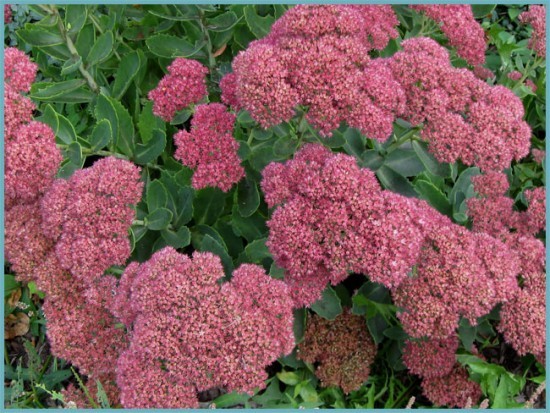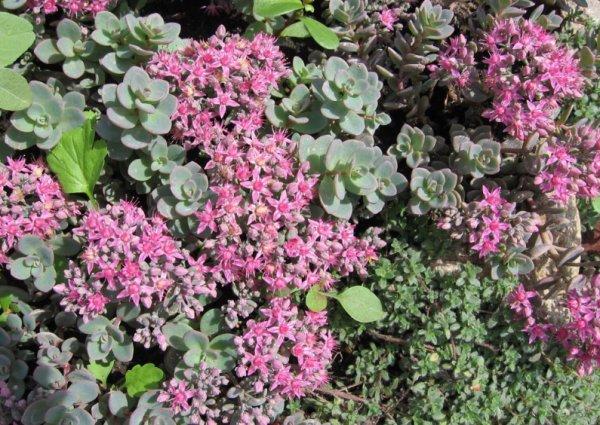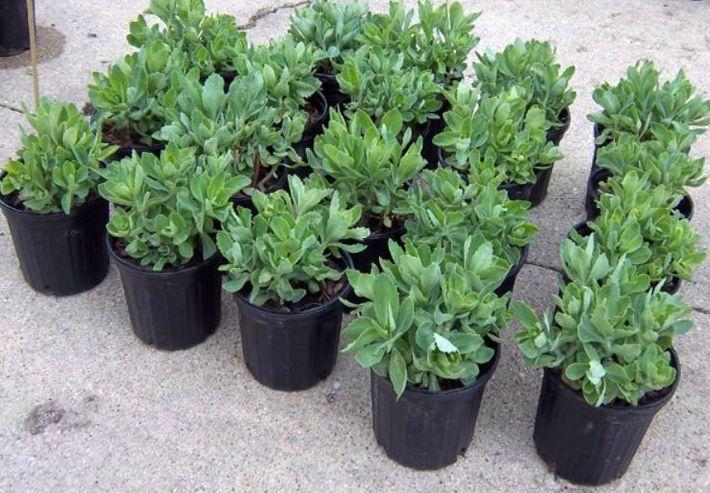Landing features
If sedum is chosen for the garden, planting will be very simple. It must be borne in mind that there are several methods of sedum propagation. There are such methods:
Seeds.
It is best to plant the seeds in early or mid spring. First you need to prepare the boxes. Fill in them with a shallow drainage, after which - a soil mixture (sand and earth). The seeds are placed at a distance of 3 cm between each other. Pour river sand on top. Moisten the soil with a spray bottle and cover the boxes with foil or glass to make a greenhouse. Some people prefer to start stratification first, which involves placing the seeds in a cold, 4 ° C, for a couple of weeks. Always ventilate the box and moisten the soil. After that, the container must be placed in a place with a temperature of 20 degrees. The film is supposed to be removed only after a month, when a lot of seedlings have already appeared. Then dive it. Inflorescences with this breeding method appear only after a couple of years.
Cuttings.
This method is considered to be the simplest. Plus it's very fast. Perfect for beginners. Another advantage is that approximately 70% of the cuttings will take root. First you need to prepare the place - level the ground. Cuttings are used before or after the end of the breeding season. Their length should be about 10 cm. Cut off all the leaves at the bottom. Then root them in the greenhouse so that at least 1 node remains above the soil surface. When the cuttings are already rooted, they are transplanted to the chosen place. You can even just cut a few cuttings and put them in the water - they will definitely take root.
Division of shrubs.
This method is suitable for tall varieties. It is necessary to choose a strong and healthy plant and dig it up. Then, with a sharp shovel, divide the root system into several parts so that each has several roots and buds. Then treat the cut site with fungicidal agents so that they heal faster. After that, dry it a little and plant it in a new place.
Be sure to choose the right seedlings before planting. They should be free of damage and signs of disease. The foliage should not be lethargic and dry. The soil in the container is moist and clean. Before buying sedum, the types of which are different, you need to fully decide on the design of the garden composition. All varieties of sedums differ in size, shape, flowering, color. Some varieties are frost-resistant. Be sure to take into account the height of the shoots. Low-growing sedums will look great if you need to arrange a carpet of flowers, but tall ones are well suited for single and group plantings.
It is imperative to choose the right place for stonecrops. A sunny and open area is best. Some varieties can feel comfortable with a slight blackout. But it is thanks to direct sunlight that the decorative properties of foliage can be emphasized. If the plant is in the shade, then it loses its beauty. Some creepers and ground cover varieties thrive on rocky terrain.
As for the choice of soil, the ideal situation would be when the garden soil is rich in nutrients, but some varieties can grow on loamy, sandy soils.
It is best to plant plants in open ground in mid or late May, when it is already known for sure that frosts are not threatening. The place needs to be prepared.Before planting sedums, the area needs to be dug into half of a shovel, compost or humus should be added. It is allowed to add sand. Then make a hole for sedum planting. In depth, it should be at least 0.2 m, and its diameter should be about 0.5 m. There should be space between the bushes, as they will grow rapidly. The distance should be at least 0.3 cm. Put small stones, sand and gravel on the bottom of the pit as a drainage layer. This will prevent stagnation of water, which adversely affects all types of stonecrops, their root system.
After that, pour out the soil mixture that has been prepared in advance. Then plant the plant and fill up the remaining soil
Press down gently with your hands. Water the flowers abundantly
From above, it is allowed to cover the soil with small pebbles or use other materials for mulching. Loosen the soil periodically and remember to water.
Description
The leaf plates are thick, dense. They have no petioles. In most cases, they are oblong with a serrated edge, but there are other forms: needle, round, oval. Their surface is both smooth and pubescent.

The leaf arrangement can be alternate, opposite or whorled. The color palette of the leaves is varied: there are light green, dark green, yellow, bluish, reddish-purple.
The upper leaves are more rounded, the lower ones are pointed, wedge-shaped. The stems are fleshy, strong. Inflorescences, located on short shoots, are usually umbellate, corymbose or racemose, rarely grow singly or in the axils.


Distribution area
In the natural environment, kandyk is found in Europe, North America, Japan, Siberia, the Caucasus, prefers mountainous areas. Siberian Kandyk is listed in the Red Book.
Kandyk can be considered a new plant for our latitudes, but it undoubtedly conquers gardeners with its delicate beauty.
When choosing the type of kandyk for planting, take into account the climatic conditions of your region. The Siberian Kandyk tolerates a drop in temperature to -50 ° C, the Caucasian Kandyk feels great at abnormally low and high air temperatures, and the Japanese Kandyk can withstand frosts down to -16 ° C, but does not tolerate the summer heat well.
Useful video
Sedum (sedum) is a close relative of the money tree. He is a member of the large Tolstyankov family. The genus Sedum unites more than 500 varieties, which are subshrubs, herbaceous plants or succulents. Among the species are one- and biennials, as well as perennial flowers. In nature, sedum grows in the temperate climates of North America, Asia and Europe.
In floriculture, succulent sedums are mainly grown. Most sedums can be planted as ampelous flowers, because in the wild they grow on stones and rocks, gracefully hanging from them. The sedum plant is a fairly common plant that does not require special care, however, it is very easy for a beginner florist to get confused in the many types and varieties of plants, so it is worthwhile to study their description and photos in detail, which will help to make the right choice.
Sedum: description and varieties
Sedum, or sedum, belongs to the genus of succulents, the fatty family. Sedum is a herbaceous plant, although most types of sedum are perennial, but one- and two-year-olds are found. Stonecrop has settled all over the planet, choosing places with a temperate climate and bright sun for life, but it is more widespread in the Northern Hemisphere.
 Sedum is beautiful with its leaves even when not in bloom
Sedum is beautiful with its leaves even when not in bloom
There are about 500 varieties of sedum, which in appearance may not be alike at all. Most sedum species are undersized, creeping and sod-forming; shrubs or semi-shrubs are less common. The shades of flowers are very different: white, yellow, greenish, pink, dark red and even blue.
The most common sedum varieties used in landscape design are:
-
Sedum prominent - a bush with high straight stems (up to 60 cm high), with light green thick leaves. Stonecrop blooms in September, and for the duration of the month its flowers, united in baskets of inflorescences, delight the eye with a beautiful pink shade.
Sedum prominent
-
Sedum telephium is a perennial shrub with unusually beautiful dark purple leaves. Flowers of red or bright pink color are collected in spectacular thyroid inflorescences.
Sedum telephium
-
Compact sedum is a perennial plant with strong stems with gray-green oblong ovoid leaves. Flowers of this species are white, with a rich aroma.
Sedum compact
-
False sedum - a perennial plant is very popular among flower growers, due to the fact that its branches form a beautiful covering, which serves to decorate carpet beds.
Sedum false
-
Caustic sedum is a frost-resistant perennial plant. Acrid sedum thickets form a sod carpet on the soil, which covers the ground all year round - this type of sedum does not lose leaves in the fall. Sedum caustic is of different varieties, which differ in shape and size, but they all have flowers of an invariably bright poisonous yellow color.
Caustic sedum
-
Sedum retracted (retracted) is a very unusual plant with thick curved stems dotted with folded densely spaced needle-like leaves. The plant resembles many outlandish furry caterpillars gathered together. And these cute caterpillars form very picturesque rugs of green shades, about 20 cm high.
Sedum reclined
Stonecrop breeding methods
Stonecrop reproduction is not particularly difficult. New plants are obtained by vegetative division and from seeds. Let's take a closer look at each method.
Seeds
Many growers get seeds from their own plants. To obtain seed, you need to withstand the peduncles until completely dry and carefully cut off. It is not easy to do this, stonecrop blooms for a long time, often until the snow itself, the seeds do not have time to ripen.
Important: sedum hybrids do not give full-fledged seeds, parental properties are not transferred. You can plant seeds on seedlings at home or directly into open ground
The second method is only suitable for warm regions.
You can plant seeds for seedlings at home or directly in open ground. The second method is only suitable for warm regions.

Cuttings
Most sedum species are easily propagated by cuttings. This method is considered to be faster and more reliable. In the spring, a stalk with 1-2 buds is cut from a bush and deepened into the ground by 2-3 centimeters. The bottom sheets must be cut off to prevent decay. The prepared cutting can be rooted in a pot, and then transferred to the ground. When cutting cuttings in autumn, young seedlings will have to be grown at home. Sedum cuttings are placed in water, and the roots are allowed to grow back. After that, they are planted in separate pots.
The sedum multiplies easily, the stem that falls to the ground quickly gives roots, forms a young plant. This property is used if sedum is already growing on the site. The soil around an adult bush is cleaned, loosened, fertilized. Press the stem to the ground with a hairpin, water it. Rooting is fast. When propagated by cuttings, a young bush fully retains the properties of an old plant.

Dividing the bush
Dividing one bush into several is another way to breed stonecrop. It is good if the sedum has already sat in one place, it is time to rejuvenate the plant
When dividing, it is important to remove the old part of the roots and bush, create viable layers with roots, buds
The cultivation and reproduction of sedum is within the power of any grower. The plant does not differ in a capricious character, grows well in drought conditions, does not need frequent feeding, pruning, and bush formation. Sedum attracts bees with a pleasant smell, contributes to pollination of neighbors. The medicinal properties of sedum are another undoubted advantage of the plant.
With the help of different types of stonecrop, you can arrange alpine slides, flower beds, and create borders. Sedum compares favorably with other flowering plants with high decorative foliage and bush. A wide variety of species and varieties allows you to design the site in accordance with the characteristics of the territory and personal tastes.
Planting sedum in the ground
In the spring, sedum seedlings, bought in nurseries, or grown at home from a cuttings, are planted in open ground, not earlier than May. Severe frosts should no longer threaten plants.

For a stonecrop seedling, dig a hole, 15 - 20 cm deep, up to half a meter in diameter. A layer of crushed stone or expanded clay is poured onto the bottom, 2-3 cm thick. The pit is filled with a mixture of sand and humus in a ratio of 3 to 1.
Stonecrop seedling is placed in the center of the fossa, spreading the roots to the sides. Sprinkle the roots, pressing and compacting the soil with your hands. The distance between sedum bushes depends on the size of the variety, but cannot be less than 25 cm. The seedling is well watered, the soil is mulched with fine gravel or granite chips.
Sedum is planted in open ground with seedlings, which are purchased in the store or grown independently. To do this, in early March, soil is poured into a small container, the seeds are laid out, a little sprinkled with a substrate and slightly moistened. Then they are covered with polyethylene, put into the vegetable tray of the refrigerator and kept for 2 weeks.
Next, the container is placed in a well-lit warm place, from time to time sprayed from a spray bottle, preventing the soil from drying out. Every day for 15-20 minutes the film is removed, allowing the planting to breathe.
Around the second half of May, when the threat of night frosts has completely passed, the seedlings are transplanted into open ground. To do this, in the prepared area, pits are dug up to 20 cm deep and drainage from expanded clay, crushed stone or broken brick is laid on their bottom. A nutritious mixture made from sand, turf and humus, taken in equal shares, is poured on top, small depressions are made in the substrate and seedlings are planted.
The distance between adjacent holes should not be less than 20 cm, otherwise the plants will be too crowded. Then the plantings are watered with warm settled water and transferred to a general care regimen. Young stonecrops begin to bloom after 2-3 years.
Benefits of growing at home
Florists have long been growing sedum at home. To ensure flowering, special conditions are required:
- moderate watering;
- lowering the temperature in winter (10-12 °);
- warmth and sun (south side) in summer;
- timely feeding.
The sedum blooms only with experienced florists who can provide the necessary conditions. Even in the absence of flowers, sedum pleases with decorative greenery, the beauty of the bush. Many people value the plant for its medicinal properties. It is used as a biostimulant, similar in effect to aloe leaves. Succulent leaves are used for wounds and skin injuries, make healing infusions for pain in the heart and hypotension.



